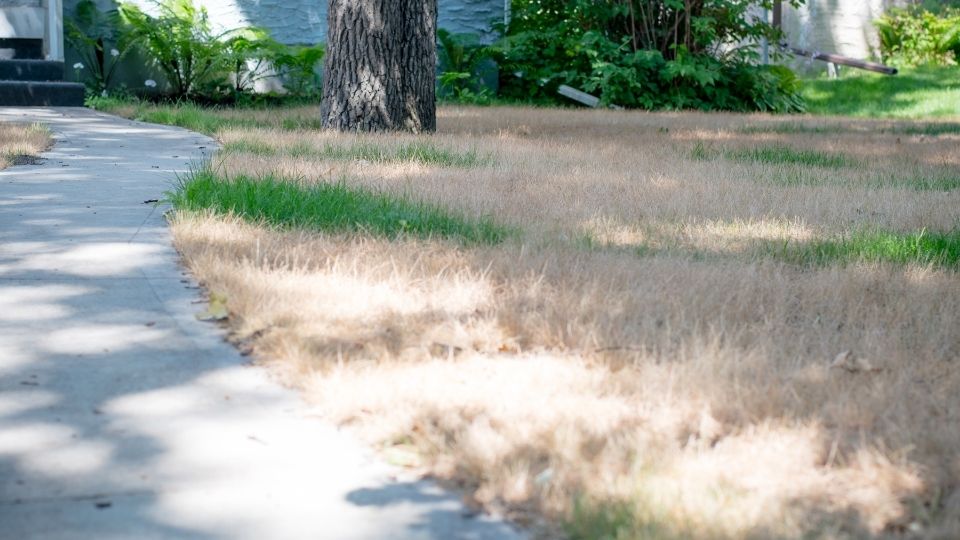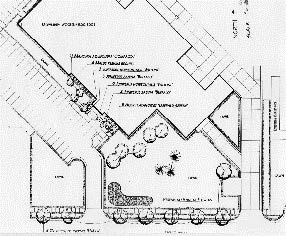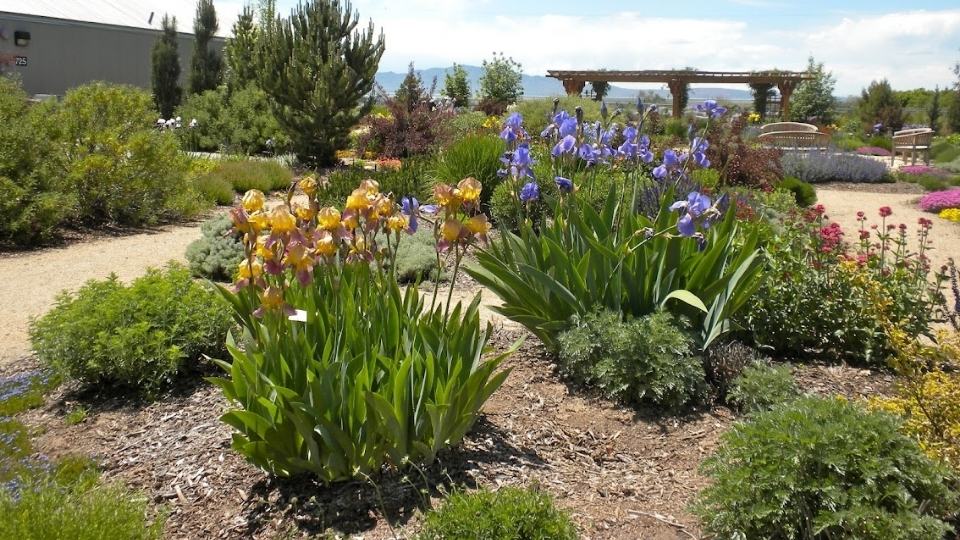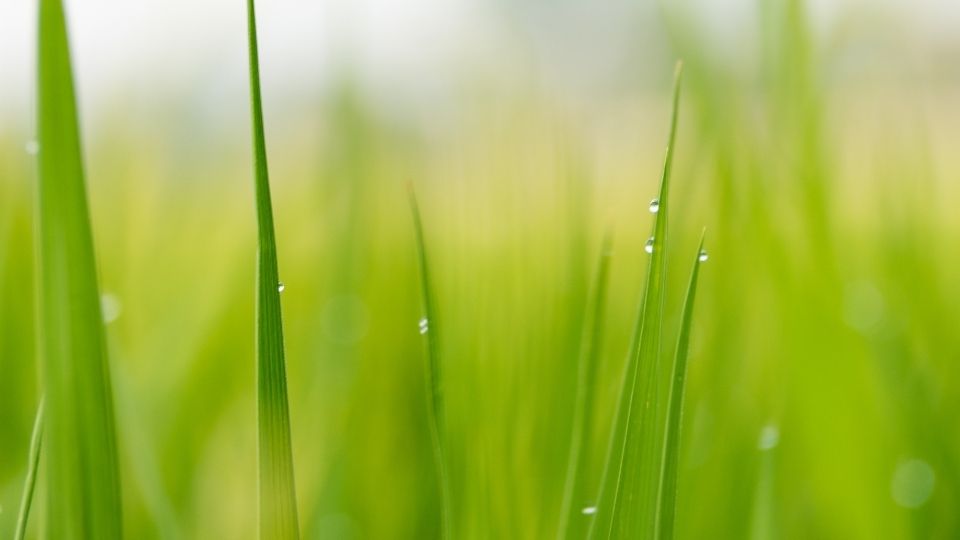Cost Free Landscape Water Conservation Ideas

sometimes be hard to see.
For many, the first thing that comes to mind when they think of landscape water conservation is changing the landscape to rocks and cacti. The good news is such change is not required. There are many simple and even free things that can be done to help conserve water in the landscape. In most landscapes, large amounts of water can be saved without changing the landscape at all. Saving water in an existing landscape usually begins with maintenance. A little time spent performing some simple sprinkler system checks can save both money and water.
Periodic System Checks
Most sprinkler systems are programmed to water early in the morning or late at night. Since evaporation is lower due to cooler temperatures and less sunlight, these times can be ideal for watering. However, watering at these times makes observing for sprinkler problems inconvenient. A good practice is to observe each irrigation zone at least once per month to look for problems. Check each sprinkler head to make sure it is functioning correctly. For automatic sprinkler systems checking heads is done by simply running each zone manually at either the valve box or the sprinkler controller. To check a system manually, first locate the sprinkler valve boxes. Sprinkler valve boxes are usually green plastic boxes buried somewhere in the landscape. Most often the green tops are visible. However, they can be difficult to see if wood chips, soil, growing grass, mulches, or other debris have covered them (Figure 1).
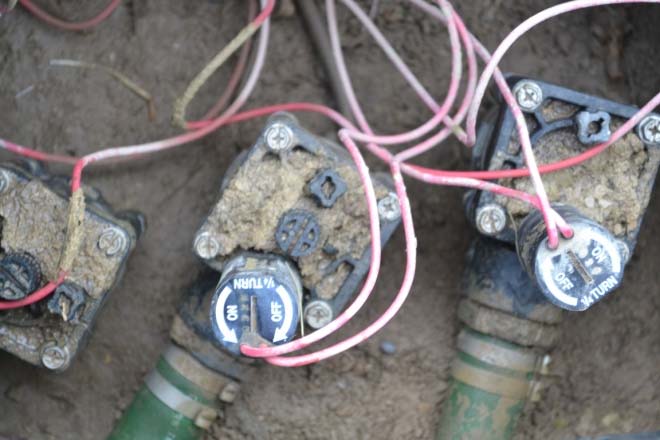
Once found, pull up the lid and open the box. Inside should be a manifold with one or more valves attached (Figure 2). A manifold simply serves as a base for solenoid valves to attach too. Each valve inside the box will control a specific zone in the sprinkler system. To turn on a zone, simply turn the solenoid to the on position by hand. When checking a zone is complete, be sure to turn the solenoid back to the off position. Complete this process for each of the zones in the sprinkler system to ensure that they are working correctly.
After all the zones have been tested, put the lid back on tightly so that it will not be hit by a mower or become a tripping hazard (Figure 3). Another way to check a sprinkler system is to run each zone using the manual override function on the sprinkler controller. Each controller is unique and will have a different set of instructions to operate it. So, it’s a good idea to consult the manual for the most efficient way to accomplish this. (Most manufactures have online versions of the manuals available to consumers.) Once the zone is running, here’s what to look for:
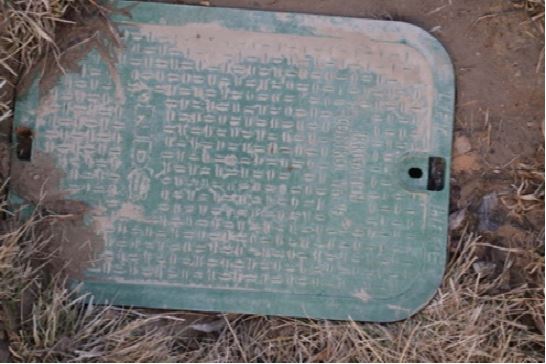
Plugged screens and filters: depending on the quality of the water source, a plugged screen or filter may happen often, as with secondary water, or be a rare occurrence if treated potable water is the source of irrigation. Checking screens and filters regularly is a good way to conserve water as plugged screens and nozzles cause uneven distribution of water in a landscape. When all nozzles are clear and spraying freely, irrigation water is applied at a uniform depth across the landscape. Poor system uniformity leads to dry spots in a landscape. These dry spots have to receive extra irrigation to compensate. When this occurs it leaves other areas on the same zone overwatered.
There are multiple types of screens and filters. Filters are usually located somewhere between where the main irrigation line enters the property and the valve box. Filters can be located above or below ground depending on the type and configuration. Often they will be located in some type of buried box similar to the sprinkler valve box.

might look like.
There are many different types of filters. In most cases, they can be cleaned relatively easily. Some types of filters have a valve which can be simply turned on while they are under pressure and they flush themselves out. Others need to be taken apart and cleaned. Once dissembled, filters can then usually be washed off with a hose and, if necessary, scrubbed with a nylon brush to remove hard to get material. IF TAKING THE FILTER APART, BE SURE TO TURN OFF THE WATER IN THE MAIN LINE FIRST!
Typically there is a master shut off valve where the irrigation line enters the property if using untreated or secondary water (Figure 4). In many systems the filter will be right after the shut off valve. After closing the master valve, confirm the water is off by manually turning on a valve to any zone in the sprinkler system. This should quickly release the pressure in the system allowing for a way to both release the residual pressure in the line and insure that the water is turned off.
Many sprinkler heads (particularly spray type heads) have removable tops with screens placed in the riser just beneath them to keep the nozzle from plugging (Figure 5). To clean these screens, it is easiest to mark each head with a flag while the sprinklers are on and then after turning the system off simply unscrew the top of the sprinkler and remove the nozzle and screen. Similar to filters, the screens can be cleaned off with water and, if necessary, a soft bristled nylon brush. Once cleaned, screens can then be put back in and the sprinkler nozzle screwed back on. (When a spray type sprinkler head is pulled up it will be under pressure from a spring. If you let go after the nozzle has been unscrewed the riser will quickly shoot back inside the sprinkler head and can be difficult to pull back out again. The easiest way to get the riser back up so that the spray nozzle can be replaced is to remove the cap from the sprinkler body, reinstall the nozzle on the riser, and then replace everything back inside the body).
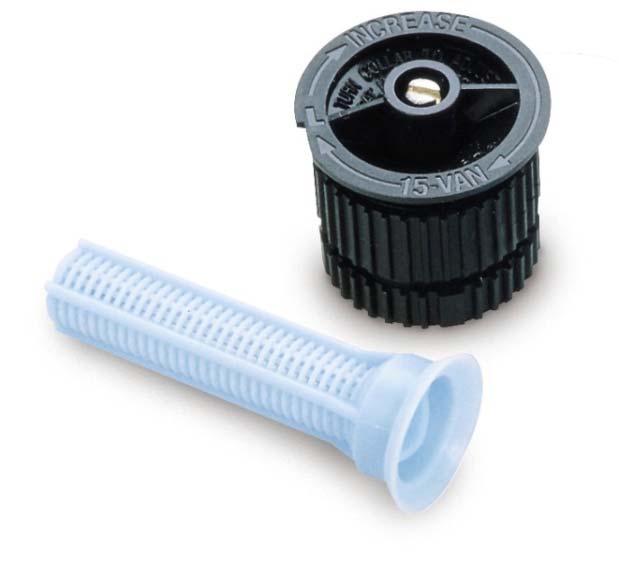
Rainbird, Inc. http://www.rainbird.com/landscape/
products/sprayNozzles/VANseriesNozzles.htm
Following cleaning, the system should then be tested to check that the sprinklers are still adjusted properly. If a sprinkler plugs up repeatedly, it may be that there is a buildup of sediment or other debris in the sprinkler line. Sometimes it is possible to flush this debris out by taking the filter and nozzle off of the sprinkler head and manually running that specific zone for a few moments. This will result in geyser of water shooting out of the disassembled head. This jet of water can clear out any debris in the lines. Care must be taken when using this method to make sure that there is nothing around that can be damaged by the stream of water. It is also important to prevent any debris from falling into the exposed pipe when the water is shut off. Following cleaning the screen, the system should then be tested to check that the sprinklers are still adjusted properly.
For a short video on cleaning out sprinkler spray head filter screens visit: http://www.rainbird.com/homeowner/support/video -1800CleaningNozzleScreen.htm
Broken, tilted, or sunken heads: The most frequent locations to see problems with sprinkler heads will be will be along driveways or other places that receive heavy traffic or are prone to being run over by vehicles Tilted sprinkler heads change the angle of spray and reduce application uniformity. The spray pattern on a sunken head is blocked because it is too low in the ground, also reducing uniformity (Figure 6). Watch for puddles or water running off from broken or leaking sprinkler heads. Another problem common problem with rotary sprinklers is damage or excessive wear over time, causing them to either stop rotating or freeze part way through a rotation. These sprinklers should be repaired or replaced.

pattern.
Blocked spray: When checking irrigation systems make sure that plants or other obstacles are not blocking a sprinkler’s spray pattern. Plants generally grow larger over time so it is important to check periodically to make sure that they have not blocked the spray pattern. Plants encroaching into the sprinkler spray pattern should either be trimmed or pruned back to allow for unobstructed watering. In some cases it may be necessary to modify or move the sprinkler so that the spray is not blocked.
Misaligned Heads: Adjust sprinklers that may be spraying onto hard surfaces such as sidewalks or roads (Figure 7). This situation not only wastes water, it can also contribute to the pollution of local waterways by washing pollutants into the sewer system.
Wind drift: If there is a consistent wind pattern (such as at the mouth of a canyon with strong morning winds) try to irrigate when the prevailing winds are calm. Wind can cause a potentially large drop in watering uniformity (Figure 8).
Low or high pressure: Sprinklers are designed to run most efficiently in a specified range of pressure. Generally spray type heads require pressures between 20 to 30 psi while most rotary heads require 50 to 80 psi to function properly. Check the pressure of a sprinkler system using a pressure gauge to make sure that it is operating within its optimal range (Figure 9). A sign that the pressure may be too high is misting from spray nozzles. Fine droplet sizes are easily carried off target by the wind or evaporate before they reach the soil. Water pressure that is too low of pressure can also be a problem causing reduced sprinkler coverage and uniformity.

across sidewalk and into road.
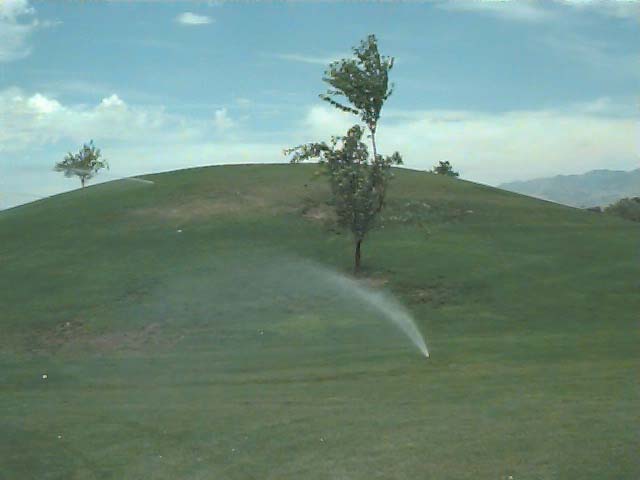
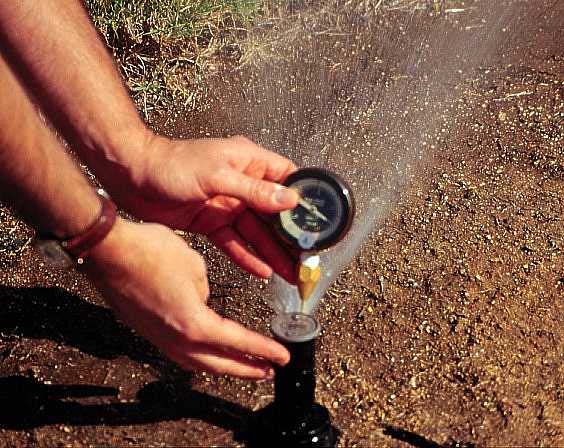
with a pitot tube and gauge.
Fine Tuning Your Sprinkler System
Water Checks: A water check is an overall checkup of an irrigation system. This system check can either be done by a homeowner or a professional. It identifies potential problems and provides the information necessary to create a customized watering schedule. A water check generally includes running the sprinkler system to check for problems such as those listed above. A catch test is also performed by placing “catch cans” around a landscape and running the irrigation system to determine the rate at which water is applied and how uniformly the sprinklers are applying the water. This information can then be used to create a watering schedule of how long and how often to run the sprinkler system. Many water conservation districts and local Extension offices have “Water Check” programs in which they will send trained individuals to perform a landscape water check free of charge. For more information on Water Checks visit the website below or contact your local Extension Office: http://www.extension.org/pages/62811/irrigationwater-checks#.Ul3qUtLEN1g
Irrigation Timing and Cycling: Irrigation efficiency can be improved by appropriately scheduling the time of irrigation, duration, and frequency. If possible water during times when there will be the least amount of evaporation. A general recommendation is not to water between the hours of 10 a.m. and 6 p.m. A good rule of thumb is to water deep and infrequently. Watering in frequent, small amounts often can cause problems for plants. This technique leads to shallow root systems which reduces the reservoir of water that plants have access to in the soil. Keeping plants continuously wet can also increase the chances of disease. Deeper root systems allow the plants to utilize more water stored in the soil before becoming water stressed. This acts as a buffer increasing plants ability to go longer without being watered.
Cycling a sprinkler system is another way to conserve water. This is done by programming a sprinkler system to irrigate in short time intervals with breaks in between to allow water to penetrate into the soil. Cycling is a particularly useful tool on landscapes that have either a high clay content or are sloped and prone to runoff. In these situations if too much water is applied too fast it can result in water running off of the landscape. This wastes water and leaves the landscape dry from the lack of water infiltration into the soil. The goal of cycling a sprinkler system is to apply the same amount of water, but to do it in multiple shorter watering’s, with time intervals in between to allow the water to soak into the soil.
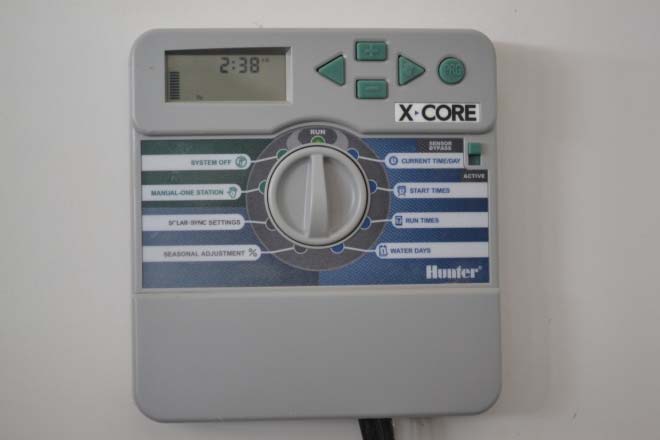
Soil Test: Since soil is the reservoir that holds water for plants, understanding its physical characteristics aids in developing an irrigation schedule. For example, knowing the soil texture and depth of the soil helps determine how much water the soil can hold and how fast it can absorb it. This information helps prevent water wasted to surface runoff or deep percolation. For more information on soils and how to determine texture, visit: http://www.weberbasin.com/conservation/images/d ocs/SoilsBasicsBrochure2011.pdf
Automatic Sprinkler Controllers: Sprinkler controllers can be a convenient and effective way to water (Figure 10). These systems are so reliable that they are often out of sight and out of mind, which can lead to unintentional over-irrigation. Most conventional controllers need to be adjusted periodically throughout the growing season as temperatures increase in the summer months and decrease again in the fall. Changes in temperature and rainfall require changes in the amount of water being applied. When adjusting for seasonal changes in irrigation it is usually best not to change how much irrigation is applied each time, but rather how frequently it is applied. For more information on watering lawns and setting up an irrigation schedule visit: http://extension.usu.edu/files/publications/factsheet/ pub__975158.pdf
Conclusion
Landscape water conservation does not have to be expensive and certainly doesn’t require a total landscape renovation with desert plants. Large amounts of water can be saved by simply programming irrigation systems to water correctly and by performing some routine checks and general maintenance to keep irrigation systems running as efficiently as possible. These basic principles can not only save homeowners money but they can also help to conserve a scarce and vital resource that we all depend on for survival.
Photography by Roger Kjelgren, Larry Rupp, and Kyle Frandsen.
Published February 2015
Utah State University Extension
Peer-reviewed fact sheet
References
- VAN Series. Retrieved January 9, 2015, from http://www.rainbird.com/landscape/products/sprayNozzles/VANseriesNozzles.html
Authors
Kyle Frandsen and Larry Rupp
Related Research



